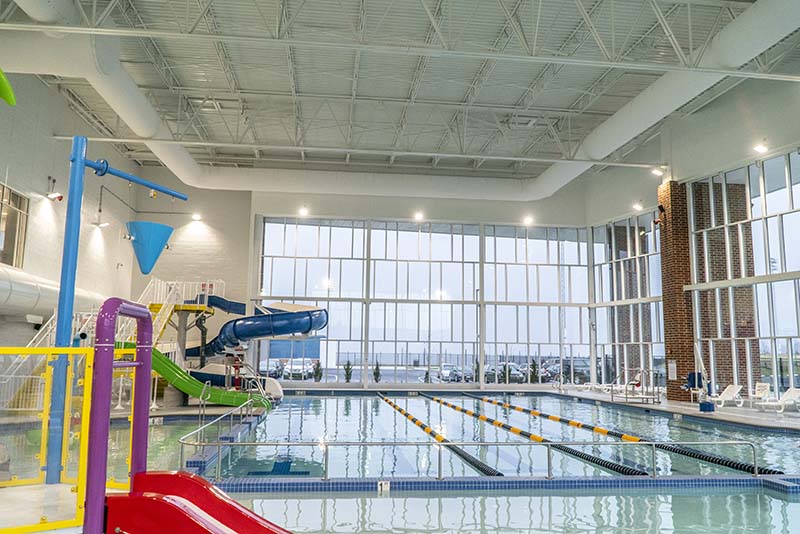There is a 90,000-square-foot aquatic center worth $48 million in Morgantown, West Virginia. The Aquatic Center at Mylan Park (ACMP) is now the home pool of the West Virginia University swimming/diving team, and hosted the 2020 Big 12 Conference championship in February of last year. The championship brought hundreds of swimmers and over 1,500 spectators. The facility includes both a competitive pool and a community pool in the same building.
But when the ACMP was being built and designed, there was a challenge. How could an effective airflow strategy ensure quality ventilation and optimal indoor air quality, without breaking the budget?
The answer: fabric duct.
Saving Money and Time
“Fabric was initially suggested by the contractor as a value engineering (cost-saving) endeavor,” said Philip Daugherty, engineering manager at FabricAir. “The design flexibility in addition to the cost savings of fabric were both major factors enabling the contractor to win the job.” It is estimated that the ductwork material reduced costs by $55,000. Using semi-custom packaged systems helped savings even more.
Project completion time was also critical to ensure the ACMP could keep up on its schedule. A full 980 linear feet of fabric ductwork needed to be hung 60 feet above the pool deck. And how long did it take? A total of 15 days for the full Olympic-sized pool and six-lane diving well.

(Courtesy of FabricAir)
Ten days were needed to install fabric duct’s single-point aluminum suspension system, plus five days to install the ductwork. The 150,000-gallon community pool’s suspension system and 360 linear feet of perimeter air dispersion installed in less than a week.
“Post installation, the fabric system required no additional sealing, painting, or balancing of the airflows,” said Daugherty. “For this particular project, balancing would have been incredibly tedious and time-consuming based on the specialized lifts required to access the duct above the spectator areas and the pool decks.”
The installation speed took six to eight weeks off the ductwork installation time, according to Chris Myers, general manager, A Durer Inc. (ADI). This meant that other trades could move up their schedules to complete the entire project faster. Plus, because of the fabric ducts’ light weight, lifting and installing the ductwork to the ceiling was safer for ADI, and it allowed them to save money on the lift equipment they needed.
Aesthetics
Good ventilation design, especially for a project as large as the ACMP, is about more than just utility and functionality. Spectators want a nice building to enjoy, and a good line of sight to watch the competition from the stands. The fabric duct looks nice — colored white to match the interior of the building — and its permeability means that airflow through the fabric surface can prevent condensation. And because of the ductwork’s flexibility, it could be ran through the truss supports near the roof (as opposed to under the trusses, which would have detracted from certain areas’ clean line of sight, as well as made the top seating area feel claustrophobic).
Preserving Indoor Air Quality
The ACMP hosted the 2020 Big 12 Conference in February 2020, right before COVID-19 brought the area to a standstill. Both the competition and the pandemic highlighted the importance of having an aquatic center that could keep its air healthy. The designers wanted air quality that could meet and exceed ASHRAE Standard 62.1. Even before these events, indoor pool health became an important issue, as poorly ventilated facilities across the world have caused respiratory issues that led to the stopping of some swim meets. Swimmers occasionally even had been rushed to the emergency room in facilities that had very poor air quality.
To ensure everyone is safe, the ACMP features two 150-ton, 65,000-cfm dehumidifiers mounted to the ground earmarked for the competitive pool, and a 90-ton, 30,000-cfm rooftop dehumidifier for the community pool. The humidifiers recover energy with hot gas reheat coils energized during the dehumidification cycles, and they recover return air energy to pre-condition outdoor air via a sensible energy recovery wheel.
In addition to this, the competition pool uses fabric duct for supply air dispersion as well as fabric duct vents to create a specialized “cross flow” of air that ensures the pool atmosphere is drawn uniformly to the dehumidifiers and the source capture exhaust system. The source capture ensures that any toxic chemicals are drawn off the water surface and exhausted outdoors.
The entire facility is monitored and controlled by building automation systems to preserve ideal temperature and humidity conditions for the safety of all spectators and swimmers.
“Fabric systems are the ideal air dispersion systems for indoor pools,” said Daugherty. “Linear dispersion (holes along the length) offers superior performance in natatoriums, as it allows for the ‘washing’ of walls, windows, and ceiling of the indoor space to prevent condensation and protect the structure.”



Report Abusive Comment